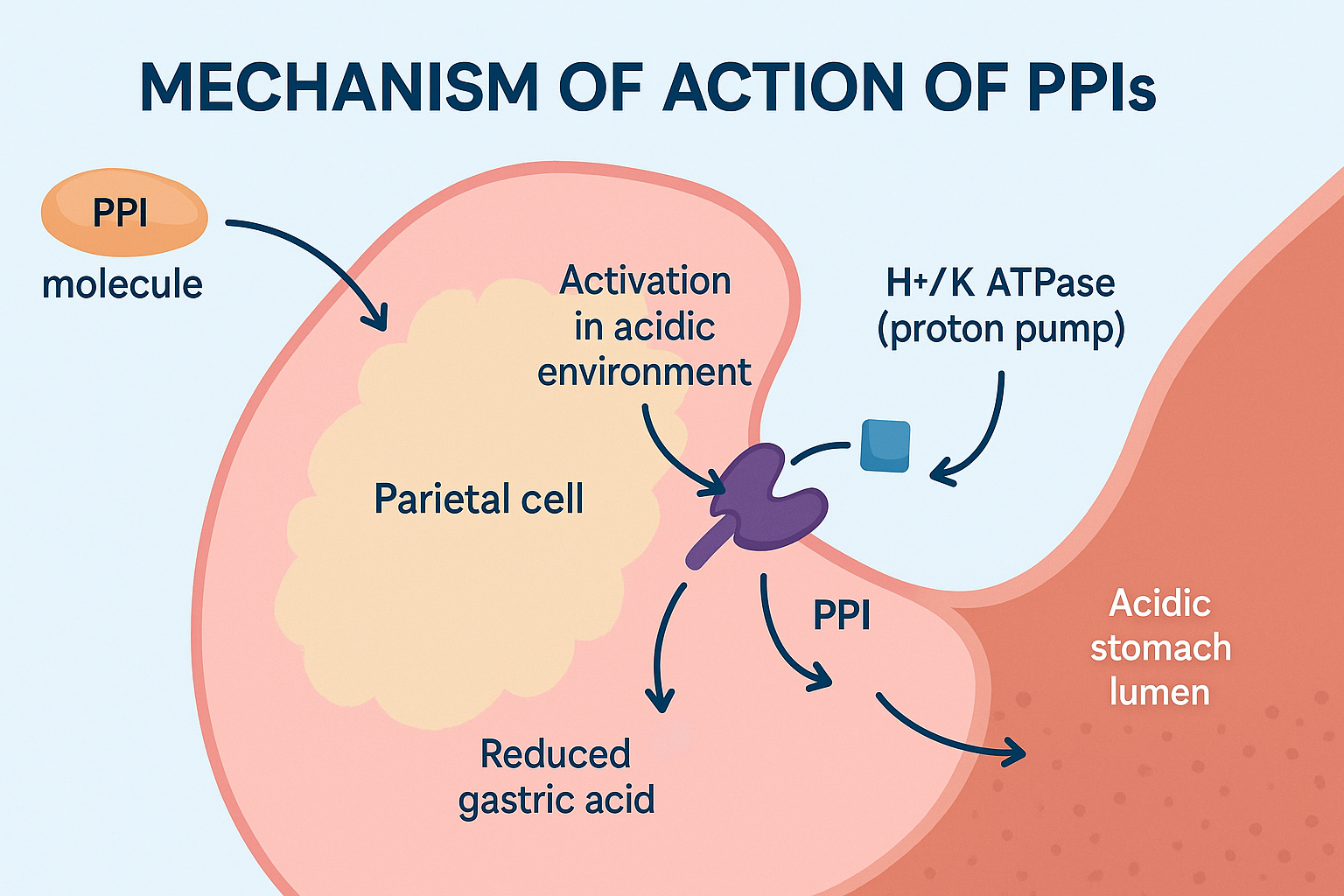Table of Contents
Introduction
Proton Pump Inhibitors (PPIs) are potent acid-suppressing drugs widely used in the treatment of gastric and duodenal ulcers, GERD, Zollinger-Ellison syndrome, and for NSAID prophylaxis. Common PPIs include omeprazole, pantoprazole, esomeprazole, and lansoprazole.
Their ability to irreversibly inhibit the H⁺/K⁺ ATPase enzyme in gastric parietal cells makes them high-yield for exams like USMLE, NCLEX, NAPLEX, GPAT, and NEET-PG — especially when learning about acid-base balance and drug metabolism.
Mechanism of Action of PPIs: Step-by-Step
- Administration as prodrugs
PPIs are lipophilic prodrugs that are absorbed in the small intestine. - Activation in acidic environment
After systemic absorption, they reach the acidic canaliculi of gastric parietal cells where they are activated to sulfenamide form. - Binding to H⁺/K⁺ ATPase enzyme
The activated PPI binds covalently to cysteine residues on the H⁺/K⁺ ATPase pump located on the apical membrane of parietal cells. - Irreversible inhibition of proton pump
This prevents hydrogen ion (H⁺) secretion into the gastric lumen, effectively blocking the final step of acid production. - Sustained acid suppression
Because inhibition is irreversible, acid secretion resumes only after new enzyme synthesis (~24–48 hrs).
Pharmacokinetic Parameters of Omeprazole (Typical PPI)
| Parameter | Value |
|---|---|
| Bioavailability | ~35–40% (reduced by food) |
| Half-life | 1–2 hours (but action lasts longer) |
| Protein binding | ~95% |
| Metabolism | Hepatic (CYP2C19, CYP3A4) |
| Excretion | Renal and biliary |
| Onset of action | ~1 hour; full effect in 3–5 days |
Clinical Uses of PPIs
- Peptic ulcer disease
- Gastroesophageal reflux disease (GERD)
- Zollinger-Ellison syndrome
- NSAID-induced ulcer prophylaxis
- Helicobacter pylori eradication (part of triple therapy)
- Stress ulcer prophylaxis in ICU patients
- Barrett’s esophagus
Adverse Effects of PPIs
- Headache and nausea
- Diarrhea or constipation
- Hypomagnesemia (long-term use)
- Vitamin B12 deficiency
- Increased risk of C. difficile infection
- Osteoporosis and fractures
- Rebound acid hypersecretion on withdrawal
Comparative Analysis: PPIs vs H2 Blockers
| Feature | PPIs | H2 Blockers |
|---|---|---|
| Target | H⁺/K⁺ ATPase (proton pump) | H2 receptors on parietal cells |
| Onset of action | Slower (days) | Faster (hours) |
| Potency | Higher | Lower |
| Duration | Long-lasting (24–48 hrs) | Shorter |
| Acid suppression | Profound | Moderate |
| Tolerance development | No | Yes (with chronic use) |
Practice MCQs
Q1. PPIs inhibit which enzyme in parietal cells?
a. Carbonic anhydrase
b. H⁺/K⁺ ATPase ✅
c. Na⁺/K⁺ ATPase
d. Gastrin receptor
Q2. What activates PPIs?
a. Liver enzymes
b. Renal excretion
c. Acidic pH in parietal canaliculi ✅
d. Light
Q3. Why do PPIs have long duration of action?
a. Long half-life
b. Irreversible inhibition ✅
c. High dose
d. Slow metabolism
Q4. Which of the following is a long-term adverse effect of PPIs?
a. Myelosuppression
b. Osteoporosis ✅
c. Alopecia
d. Hepatotoxicity
Q5. Which drug class reduces efficacy of PPIs?
a. Antacids
b. Antihistamines
c. H2 blockers
d. Clopidogrel (via CYP2C19 interaction) ✅
Q6. Which is a common use of PPIs?
a. Epilepsy
b. Hypertension
c. GERD ✅
d. Anemia
Q7. PPIs are contraindicated in:
a. Pregnancy
b. Children
c. Known hypersensitivity ✅
d. Diabetes
Q8. Which PPI is part of triple therapy for H. pylori?
a. Esomeprazole ✅
b. Ranitidine
c. Misoprostol
d. Domperidone
Q9. Rebound hyperacidity occurs when:
a. Taken with food
b. Suddenly stopped ✅
c. Given IV
d. Given in small dose
Q10. Which mineral deficiency may result from chronic PPI use?
a. Iron
b. Zinc
c. Magnesium ✅
d. Potassium
FAQs
Q1: Can PPIs be used during pregnancy?
Yes, PPIs like omeprazole and pantoprazole are generally considered safe in pregnancy.
Q2: Why are PPIs preferred over H2 blockers in GERD?
Because PPIs provide more potent and sustained acid suppression.
Q3: How long does it take for PPIs to start working?
It may take 2–3 days for full acid suppression.
Q4: Can I take PPIs with food?
They are best taken before meals for optimal activation in acidic environments.
Q5: Why monitor magnesium levels with PPIs?
Hypomagnesemia can occur with long-term use, especially in elderly or those on diuretics.
References
- KD Tripathi – Essentials of Medical Pharmacology
- Goodman & Gilman – The Pharmacological Basis of Therapeutics
- Sparsh Gupta – Review of Pharmacology
- NCBI: https://www.ncbi.nlm.nih.gov/books/NBK430926/
I am pursuing MBA in pharmaceutical management from NIPER Hyderabad with a strong academic record and proven success in national-level pharmacy entrance exams. I secured AIR 61 in NIPER 2024 (MS/M.Pharm) and AIR 27 in NIPER MBA, along with AIR 147 in GPAT 2024 and AIR 907 in GPAT 2023. I also achieved AIR 6 in AIIMS CRE-2025 for Drug Store Keeper and was selected as a Pharmacist (AIR 61) for ESIC. Additionally, I was the Runner-Up in Round 2 of the EY Case Study Competition.
At PharmacyFreak.com, I aim to guide future pharmacists through expert content, exam strategies, and insightful resources based on real experience and academic excellence.
Mail- harsh@pharmacyfreak.com
